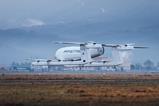Airbus Helicopters is continuing to ramp-up flights of its H145-based PioneerLab demonstrator as it looks to validate the latest autonomous control technologies prior to the installation of a hybrid-electric powertrain in 2025.
Unveiled in September 2023, the light-twin helicopter is designed to serve as a testbed for three main technology streams: autonomous flight controls, measures to improve fuel burn by 30%, and the application of low-impact bio-based materials.

To date, the airframer has focused on the first of those pillars, said Johannes Plaum, head of research and technology at Airbus Helicopters Deutschland, speaking next to the PioneerLab at the ILA Berlin air show on 6 June.
A version of the company’s radar-based rotor strike alerting system (RSAS) designed for twin-engined helicopters has been installed on the roof line of the cabin, while a nose-mounted Lidar sensor and optical cameras on the skid-gear, combined with a digital terrain database, help to build up a picture of the aircraft’s surroundings.
“But the trick is really to process and fuze all the data generated by these cameras to build up a synthetic field [of view] around the helicopter that gives you awareness of any obstacles,” says Plaum.
That data is then fed into the flight-control computer and autopilot system to enable autonomous flights “from take-off to touch-down”.
To achieve the required precision, an additional pressure sensor was integrated into the skid gear to accurately detect the moment of contact with the ground, regardless of the terrain or slope angle.
Testing of the autonomous flight-controls will continue throughout this year and the first half of 2025, before the PioneerLab is laid up in the second half to receive its hybrid-electric powertrain.
Plaum offers few details about the architecture but says the battery electric portion of the system will be sized to deliver 500kW – double the power of the hybrid-electric powertrain on the airframer’s DisruptiveLab demonstrator.
“It is near to the power of a thermal engine,” he adds. “It is really, really ambitious.”
While disclosing that the powertrain goes beyond the simple emergency back-up system previously tested aboard the manufacturer’s H130-based FlightLab aircraft, Plaum does not elaborate further.
“It will be a combination of a classical gas turbine with an electric motor,” he says. “But it will be a different set up to anything here today.”
He notes that the popularity of light-twin helicopters in Europe was spurred by regulations governing the commercial operation of rotorcraft in urban environments. But the requirement for two engines adds weight, cost and complexity – and sees the powerplants running at lower efficiency levels.
“Our idea is to change that to have electric energy when it is necessary to complement the turbine engine [and] to have the engine running at a more efficient point.” Could that see one thermal engine removed from the existing architecture? Plaum declines to say.
The design work for the modifications is “more or less done” and Airbus Helicopters is preparing the hardware for future installation.
Plaum is also reluctant to discuss the supplier of the hybrid powertrain. The stock H145 is equipped with twin Safran Helicopter Engines Arriel 2Es, each rated at 667shp (894kW).
Flight tests of the hybrid system are expected to begin in 2026 and run up until the end of the project in 2027.
Meanwhile, the airframer is preparing a series of aerodynamic improvements for the PioneerLab, mainly focused on the aft portion of the helicopter. These will cut drag in forward flight and reduce the interaction of the rotorwash on the airframe while in the hover.
In the latter case, that could include an asymmetric tail boom – similar to that seen on the Racer high-speed demonstrator – using an airfoil shape to reduce the amount of power needed for anti-torque control.
Lastly, Airbus Helicopters has been researching the use of bio-based materials on the aircraft. The first component produced through this initiative – a nose panel made from synthetic acrylonite-derived biofibre – began flight testing on the PioneerLab in May to prove the material’s airworthiness.































